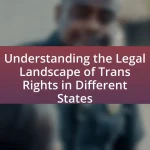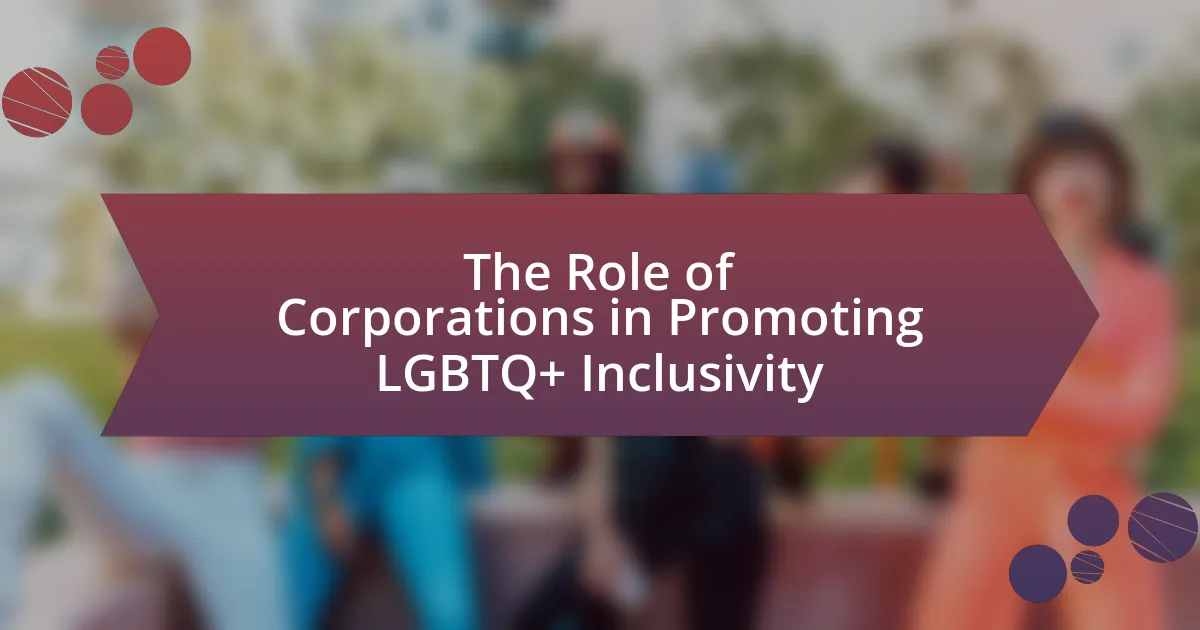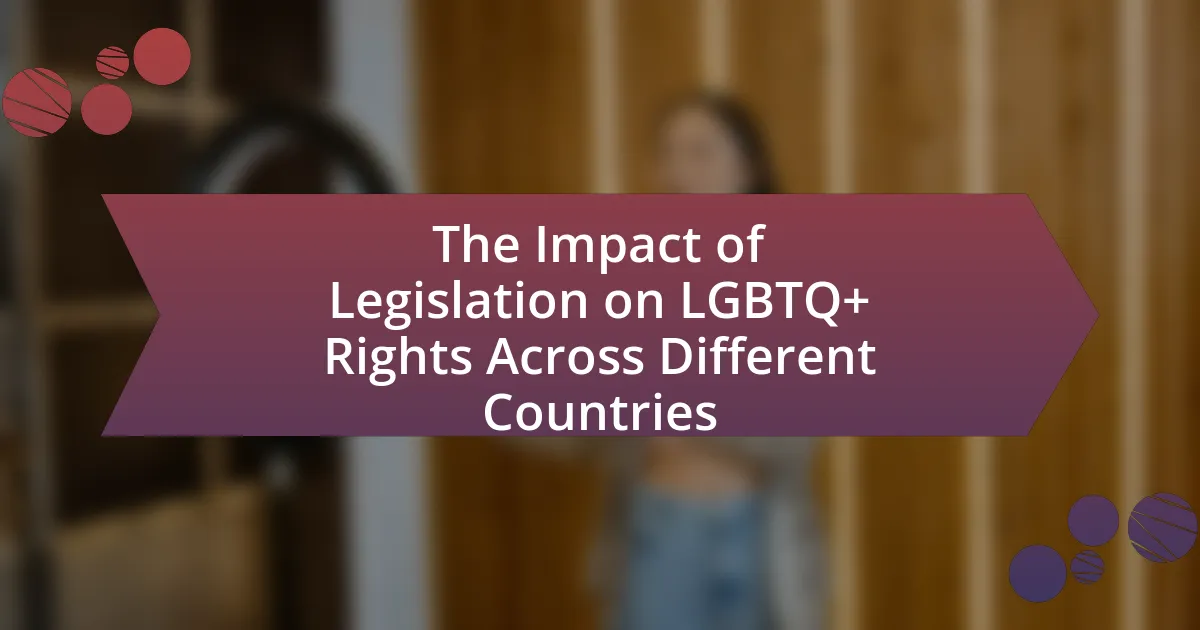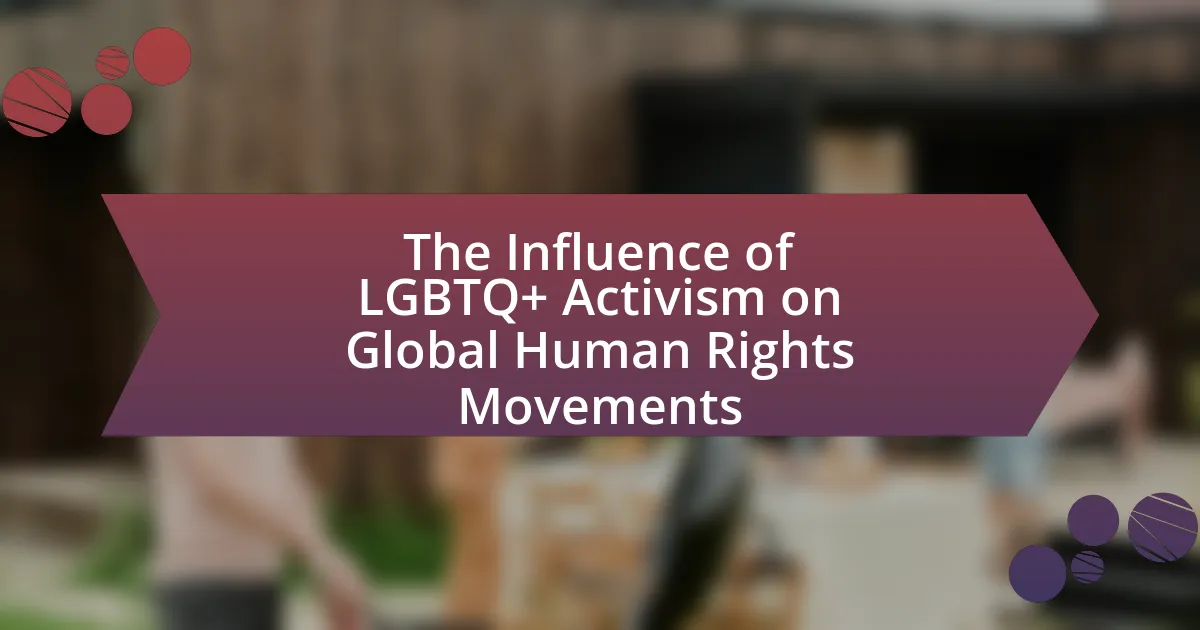The article examines the critical intersection of climate change and LGBTQ+ rights, highlighting the unique vulnerabilities faced by LGBTQ+ communities during environmental crises. It discusses how climate change exacerbates existing social inequalities, leading to increased risks of homelessness, discrimination, and health disparities among LGBTQ+ individuals. The article emphasizes the importance of integrating LGBTQ+ perspectives into climate action policies to ensure equitable protections and effective responses to climate-related challenges. Additionally, it outlines specific challenges, potential consequences of neglecting this intersection, and actionable steps for advocacy and collaboration to support both climate justice and LGBTQ+ rights.

What is the Intersection of Climate Change and LGBTQ+ Rights?
The intersection of climate change and LGBTQ+ rights involves the unique vulnerabilities faced by LGBTQ+ communities in the context of environmental crises. Research indicates that marginalized groups, including LGBTQ+ individuals, often experience heightened risks during climate-related disasters due to social and economic inequalities. For example, a study by the Human Rights Campaign highlights that LGBTQ+ people are more likely to face discrimination in emergency response situations, which can exacerbate their exposure to climate impacts. Additionally, climate change can intensify existing health disparities within LGBTQ+ populations, as they may have limited access to healthcare and support systems during environmental emergencies. Thus, addressing climate change is crucial for advancing LGBTQ+ rights and ensuring equitable protections for all communities.
How do climate change and LGBTQ+ rights intersect?
Climate change and LGBTQ+ rights intersect primarily through the disproportionate impact of environmental issues on marginalized communities, including LGBTQ+ individuals. Research indicates that climate change exacerbates existing social inequalities, leading to increased vulnerability for LGBTQ+ populations, particularly in areas such as housing, health, and access to resources. For instance, studies show that LGBTQ+ individuals often face higher rates of homelessness and discrimination, which are intensified during climate-related disasters. Furthermore, advocacy for LGBTQ+ rights within climate action frameworks highlights the need for inclusive policies that address the unique challenges faced by these communities, ensuring that their voices are represented in climate resilience and adaptation strategies.
What are the specific challenges faced by LGBTQ+ communities due to climate change?
LGBTQ+ communities face specific challenges due to climate change, including increased vulnerability to natural disasters, mental health issues, and discrimination in disaster response. Natural disasters disproportionately affect LGBTQ+ individuals, particularly those who are homeless or lack supportive networks, as evidenced by studies showing higher rates of displacement among LGBTQ+ youth during climate-related events. Additionally, climate change exacerbates mental health challenges within these communities, with research indicating that environmental stressors can lead to increased anxiety and depression. Discrimination in disaster response further complicates recovery efforts, as LGBTQ+ individuals may encounter bias from emergency services, hindering their access to essential resources and support.
How does climate change exacerbate existing inequalities for LGBTQ+ individuals?
Climate change exacerbates existing inequalities for LGBTQ+ individuals by disproportionately impacting marginalized communities that often lack resources to adapt. Research indicates that LGBTQ+ individuals face higher rates of homelessness and discrimination, which are intensified during climate-related disasters. For instance, a study by the Human Rights Campaign highlights that LGBTQ+ youth are 120% more likely to experience homelessness compared to their heterosexual peers, making them more vulnerable during climate crises. Additionally, systemic barriers in healthcare access can hinder LGBTQ+ individuals from receiving necessary support during climate-related health emergencies, further deepening their vulnerability.
Why is it important to address both climate change and LGBTQ+ rights together?
Addressing both climate change and LGBTQ+ rights together is important because marginalized communities, including LGBTQ+ individuals, are disproportionately affected by climate-related disasters and policies. Research indicates that climate change exacerbates existing inequalities, leading to increased vulnerability for LGBTQ+ populations who may lack access to resources and support systems during crises. For instance, the 2019 report by the United Nations highlights that LGBTQ+ individuals face higher risks of displacement and violence in the context of climate emergencies. Therefore, integrating LGBTQ+ rights into climate action ensures that solutions are equitable and inclusive, ultimately fostering resilience in all communities.
What are the potential consequences of ignoring this intersection?
Ignoring the intersection of climate change and LGBTQ+ rights can lead to significant social and environmental consequences. Specifically, marginalized LGBTQ+ communities often face heightened vulnerabilities during climate-related disasters, resulting in increased health risks, displacement, and economic instability. For instance, studies show that LGBTQ+ individuals are more likely to experience homelessness and discrimination, which exacerbates their challenges in accessing resources during climate emergencies. Furthermore, neglecting this intersection can perpetuate systemic inequalities, hindering effective climate action and social justice initiatives. This lack of attention can ultimately undermine efforts to create inclusive policies that address both climate change and the rights of LGBTQ+ individuals, leading to broader societal discord and inequity.
How can addressing both issues lead to more effective solutions?
Addressing both climate change and LGBTQ+ rights can lead to more effective solutions by fostering inclusive policies that recognize the interconnectedness of social justice and environmental sustainability. When policymakers integrate LGBTQ+ perspectives into climate action plans, they can create strategies that are equitable and address the unique vulnerabilities faced by marginalized communities. For instance, research shows that marginalized groups, including LGBTQ+ individuals, often experience disproportionate impacts from climate-related disasters, highlighting the need for targeted interventions. By ensuring that climate solutions are inclusive, governments can enhance community resilience and promote social equity, ultimately leading to more comprehensive and effective responses to both issues.

What are the impacts of climate change on LGBTQ+ communities?
Climate change disproportionately impacts LGBTQ+ communities by exacerbating existing social inequalities and increasing vulnerability to environmental disasters. Studies indicate that LGBTQ+ individuals often face higher rates of homelessness and mental health issues, which are intensified during climate-related events such as hurricanes, floods, and heatwaves. For example, the 2020 report by the Human Rights Campaign highlights that LGBTQ+ youth are more likely to experience homelessness, making them particularly susceptible to the adverse effects of climate change. Additionally, marginalized LGBTQ+ populations, including people of color and those with lower socioeconomic status, face compounded risks due to systemic discrimination and lack of access to resources, further illustrating the intersection of climate change and social justice within these communities.
How does climate change affect the health and safety of LGBTQ+ individuals?
Climate change adversely affects the health and safety of LGBTQ+ individuals by exacerbating existing vulnerabilities and increasing exposure to health risks. LGBTQ+ individuals often face higher rates of mental health issues, discrimination, and social isolation, which are intensified during climate-related disasters such as floods, heatwaves, and wildfires. For instance, a study published in the journal “Environmental Research Letters” highlights that marginalized communities, including LGBTQ+ populations, experience disproportionate impacts from climate change due to systemic inequalities. Additionally, during emergencies, LGBTQ+ individuals may encounter barriers to accessing healthcare and support services, further compromising their safety and well-being.
What specific health risks are heightened for LGBTQ+ populations in a changing climate?
LGBTQ+ populations face heightened health risks in a changing climate, including increased mental health issues, higher rates of heat-related illnesses, and greater vulnerability to infectious diseases. Climate change exacerbates existing social inequalities, leading to increased stress and anxiety among LGBTQ+ individuals, particularly those in marginalized communities. For instance, studies indicate that extreme weather events can lead to displacement, which disproportionately affects LGBTQ+ individuals who may lack supportive networks. Additionally, rising temperatures can worsen chronic health conditions and increase the risk of heat exhaustion, particularly for those with limited access to healthcare. Research from the American Public Health Association highlights that climate-related disruptions can also hinder access to essential health services, further endangering the well-being of LGBTQ+ populations.
How do natural disasters disproportionately impact LGBTQ+ communities?
Natural disasters disproportionately impact LGBTQ+ communities due to pre-existing social vulnerabilities and systemic inequalities. Research indicates that LGBTQ+ individuals often face higher rates of homelessness, discrimination, and lack of access to healthcare, which are exacerbated during and after disasters. For instance, a study by the Human Rights Campaign found that LGBTQ+ youth are 120% more likely to experience homelessness compared to their heterosexual peers, making them particularly susceptible to the adverse effects of natural disasters. Additionally, emergency response systems may not adequately address the unique needs of LGBTQ+ individuals, leading to further marginalization and increased risk during crises.
What role does discrimination play in the context of climate change?
Discrimination exacerbates the impacts of climate change by disproportionately affecting marginalized communities, including LGBTQ+ individuals. These groups often face systemic inequalities that limit their access to resources, decision-making processes, and adaptive capacities in the face of climate-related challenges. For instance, studies indicate that LGBTQ+ populations are more likely to experience homelessness and poverty, which heightens their vulnerability to climate disasters. Additionally, discriminatory policies can hinder effective climate action, as marginalized voices are often excluded from environmental discussions and solutions, leading to inadequate responses that fail to address their specific needs.
How does systemic discrimination affect access to resources during climate crises?
Systemic discrimination significantly limits access to resources during climate crises, particularly for marginalized communities. This discrimination manifests through unequal distribution of aid, lack of representation in decision-making processes, and barriers to accessing financial resources. For instance, studies show that LGBTQ+ individuals often face heightened vulnerability during disasters due to social stigma and exclusion from support networks, which can impede their ability to secure necessary resources like shelter, food, and medical care. Additionally, systemic inequalities can lead to inadequate infrastructure in marginalized neighborhoods, exacerbating the impacts of climate-related events and hindering recovery efforts.
What are the implications of climate migration for LGBTQ+ individuals?
Climate migration significantly impacts LGBTQ+ individuals by exacerbating existing vulnerabilities and discrimination. As climate change forces populations to relocate, LGBTQ+ individuals often face heightened risks of violence, exclusion, and lack of access to essential services in new environments. Research indicates that marginalized groups, including LGBTQ+ individuals, are disproportionately affected by climate-related disasters, leading to increased mental health issues and social isolation. For instance, a study by the Human Rights Campaign highlights that LGBTQ+ youth are more likely to experience homelessness after climate-induced displacement, further complicating their access to safety and support systems.

What actions can be taken to advocate for LGBTQ+ rights in the context of climate change?
Advocating for LGBTQ+ rights in the context of climate change can be achieved through several key actions. First, individuals and organizations can promote inclusive climate policies that specifically address the needs of LGBTQ+ communities, ensuring their voices are represented in climate discussions. For instance, research indicates that marginalized groups, including LGBTQ+ individuals, often face disproportionate impacts from climate change, highlighting the necessity for targeted advocacy.
Second, forming coalitions between LGBTQ+ organizations and environmental groups can amplify efforts to address both climate justice and LGBTQ+ rights. Collaborative initiatives can lead to comprehensive strategies that tackle the intersectionality of these issues.
Third, raising awareness through educational campaigns about how climate change disproportionately affects LGBTQ+ populations can mobilize support and foster community resilience. Studies show that climate-related disasters can exacerbate existing inequalities, making it crucial to inform the public and policymakers about these dynamics.
Lastly, supporting legislation that protects both environmental and LGBTQ+ rights can create a legal framework that promotes equity and sustainability. For example, the Green New Deal includes provisions for social justice, which can be leveraged to advocate for LGBTQ+ rights within climate action frameworks.
How can activists effectively raise awareness about this intersection?
Activists can effectively raise awareness about the intersection of climate change and LGBTQ+ rights by leveraging social media platforms to disseminate information and engage communities. Social media allows for the rapid sharing of educational content, personal stories, and calls to action, reaching diverse audiences. For instance, campaigns like #ClimateJustice and #LGBTQClimate have successfully highlighted how climate policies disproportionately affect marginalized communities, including LGBTQ+ individuals. Research indicates that social media campaigns can increase public engagement and awareness by up to 60%, demonstrating their effectiveness in mobilizing support and fostering dialogue around critical issues.
What strategies have proven successful in mobilizing support for LGBTQ+ rights and climate action?
Successful strategies for mobilizing support for LGBTQ+ rights and climate action include coalition-building, leveraging social media campaigns, and integrating intersectional advocacy. Coalition-building among LGBTQ+ organizations and environmental groups has created a unified front, exemplified by initiatives like the Queer Eco-Justice Project, which highlights the interconnectedness of social justice and environmental sustainability. Social media campaigns, such as the #ClimatePride movement, have effectively raised awareness and engaged younger audiences, demonstrating the power of digital platforms in advocacy. Additionally, integrating intersectional advocacy ensures that the unique challenges faced by LGBTQ+ individuals in the context of climate change are addressed, as seen in reports from organizations like the Human Rights Campaign, which emphasize the need for inclusive policies that consider both climate and social justice.
How can community organizations collaborate to address these issues?
Community organizations can collaborate to address the intersection of climate change and LGBTQ+ rights by forming coalitions that leverage their unique strengths and resources. These coalitions can facilitate joint initiatives, such as awareness campaigns that highlight how climate change disproportionately affects LGBTQ+ communities, particularly in areas like housing instability and health disparities. For instance, organizations can share data and research, such as the 2021 report by the Human Rights Campaign, which outlines the vulnerabilities faced by LGBTQ+ individuals in climate-affected regions. By pooling funding and expertise, community organizations can also develop targeted programs that provide support and resources to LGBTQ+ individuals impacted by climate-related events, ensuring that their specific needs are addressed in broader climate action plans.
What policies can be implemented to support LGBTQ+ communities in climate action?
Policies that can be implemented to support LGBTQ+ communities in climate action include inclusive climate resilience planning, equitable access to funding for green initiatives, and targeted outreach programs. Inclusive climate resilience planning ensures that LGBTQ+ individuals are represented in decision-making processes, addressing their unique vulnerabilities to climate impacts. Equitable access to funding for green initiatives can help LGBTQ+ organizations develop sustainable practices and projects, as evidenced by studies showing that marginalized communities often face barriers to funding. Targeted outreach programs can educate and engage LGBTQ+ communities in climate action, fostering participation and collaboration, which is crucial for effective climate strategies.
What are some examples of effective policies that address both climate change and LGBTQ+ rights?
Effective policies that address both climate change and LGBTQ+ rights include the incorporation of LGBTQ+ inclusivity in climate action plans and the establishment of funding mechanisms for climate resilience that prioritize marginalized communities. For instance, the Climate Justice Alliance emphasizes the need for policies that integrate social equity, ensuring that LGBTQ+ individuals are considered in climate adaptation strategies. Additionally, the Green New Deal in the United States proposes job creation in renewable energy sectors while advocating for social justice, which includes protections for LGBTQ+ workers. These policies demonstrate a commitment to addressing the dual challenges of climate change and LGBTQ+ rights, ensuring that both issues are tackled simultaneously for equitable outcomes.
How can policymakers ensure inclusivity in climate action plans?
Policymakers can ensure inclusivity in climate action plans by actively engaging marginalized communities, including LGBTQ+ individuals, in the decision-making process. This engagement can be achieved through public consultations, focus groups, and partnerships with local organizations that represent diverse populations. Research indicates that inclusive climate policies lead to more effective outcomes, as they address the unique vulnerabilities and needs of all community members. For instance, the United Nations Framework Convention on Climate Change emphasizes the importance of participatory approaches to ensure that the voices of underrepresented groups are heard and considered in climate strategies.
What practical steps can individuals take to support this cause?
Individuals can support the intersection of climate change and LGBTQ+ rights by advocating for inclusive environmental policies. Engaging in local activism, such as participating in climate marches that prioritize LGBTQ+ representation, helps raise awareness about the unique vulnerabilities faced by LGBTQ+ communities in climate crises. Supporting organizations that focus on both climate justice and LGBTQ+ rights, like the Climate Justice Alliance, can amplify efforts to address these interconnected issues. Additionally, individuals can educate themselves and others about the impacts of climate change on marginalized communities, fostering a more inclusive dialogue around environmental sustainability.
How can individuals advocate for LGBTQ+ rights in their local climate initiatives?
Individuals can advocate for LGBTQ+ rights in local climate initiatives by actively participating in community discussions and decision-making processes that address both climate change and social equity. Engaging with local government, attending town hall meetings, and joining advocacy groups focused on environmental justice can amplify the voices of LGBTQ+ individuals, ensuring their needs and perspectives are included in climate policies. Research indicates that marginalized communities, including LGBTQ+ populations, are disproportionately affected by climate change, highlighting the necessity for inclusive approaches in climate action plans. By promoting intersectional policies that recognize the unique challenges faced by LGBTQ+ individuals in the context of climate change, advocates can foster a more equitable and effective response to environmental issues.
What resources are available for those looking to get involved?
Resources available for those looking to get involved in the intersection of climate change and LGBTQ+ rights include advocacy organizations, educational materials, and community initiatives. Organizations such as the Human Rights Campaign and the Sierra Club provide platforms for activism, offering toolkits and guides for engagement. Additionally, online resources like webinars and workshops focus on the specific challenges faced by LGBTQ+ communities in the context of climate change. Research indicates that marginalized groups, including LGBTQ+ individuals, are disproportionately affected by environmental issues, highlighting the importance of targeted involvement.




